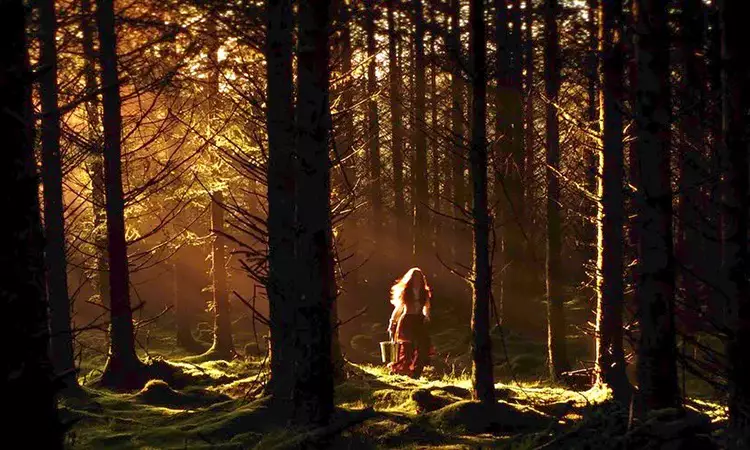In the Irish film “An Taibhse” (The Ghost), writer and director John Farrelly delivers a narrative that intertwines the supernatural with the psychological, exploring the tumultuous landscape of childhood trauma and the daunting shadows that haunt both the living and the dead. The film opens with a stark confrontation of fear and reality, as young Máire Finegan and her father Éamon traverse the darkness of a remote estate. The mention of Alexander, a name that erupts with haunting implications, resonates throughout the film, establishing a thematic crux of ambiguity that weaves through its gothic setting.
Set in a sprawling, decaying mansion, “An Taibhse” captures a distinct gothic atmosphere reminiscent of classic horror tales. The estate is not merely a backdrop but a character in itself, presenting long, eerie corridors and rooms steeped in shadow. This isolation serves to amplify the escalating tension between the father and daughter as they navigate the suffocating gloom of both their physical surroundings and their emotional lives. The oppressive environment mirrors Máire’s psychological struggles, suggesting that the true horror lies not in the supernatural, but in the very real threats posed by her father’s deteriorating mental state.
At the heart of Máire’s journey is the recent death of her mother, an event that casts a long shadow over her psyche. Farrelly deftly showcases how grief can morph into a fertile ground for fear and imagination. The character of Alexander emerges as a potentially supernatural figure, leaving viewers questioning whether he is a manifestation of Máire’s grief, or an authentic specter. The ambiguity surrounding Alexander sets the tone for the film, inviting audiences to interpret these encounters as either an exploration of childhood fears or a reflection of the fragile boundary between reality and fantasy.
As the narrative progresses, it becomes evident that the specters lurking in the mansion—whether Alexandra, the ghostly Punch puppet, or even Éamon himself—represent various facets of trauma and psychological breakdown. Máire’s perception of reality begins to warp, and her disorientation is exacerbated as her father becomes increasingly unstable under the influence of alcohol, paralleling her internal chaos with the external turmoil of their environment.
As her father’s dependence on alcohol deepens, so does the emotional burden placed on young Máire. She transforms from a child into a caregiver, shouldering responsibilities meant for adults, mirroring the loss of her innocence. The film juxtaposes the notion of real threats posed by an unstable father with the more fantastical fears embodied by Alexander and other spectral images. In doing so, “An Taibhse” delivers a profound commentary on how trauma forces children to confront fears that extend beyond the tangible, leading to nightmarish encounters that may or may not be rooted in reality.
This duality of horror manifests in the film’s most haunting imagery—the father’s transformation into a figure of chaos is as unsettling as the appearance of the supernatural. Éamon becomes a representation of the horror that can exist in the domestic sphere, complicating Máire’s journey into maturity as she navigates her fear of him alongside her fear of the unknown.
As much as “An Taibhse” is a ghost story, it is equally a tale of adolescence and maturation. The arrival of Máire’s menarche signifies her entrance into womanhood, intertwined with the film’s themes of blood—both literal and metaphorical. The recurring emergence of a crimson book symbolizes forbidden knowledge and the complex interplay between innocence and adult realities. Through her vivid dreams and haunting experiences, Máire experiences the frightful awakening of her sexuality and identity, adding layers of complexity to her journey through trauma-induced turmoil.
Farrelly’s use of editing and lighting heavily contributes to the film’s unsettling ambiance, where the absence of overt special effects creates a suffocating sense of dread. It is within these spectral encounters and dream sequences that the audience witnesses a young girl clinging to the remnants of her childhood, desperately seeking safety in an environment that increasingly becomes a prison.
“An Taibhse” paints a vulnerably human picture of horror—one that resonates on levels that exceed mere ghostly encounters. In the film, Máire’s haunting experiences become a metaphor for her shattered childhood, navigating both the threat of external phantoms and the internal demons forged from loss and trauma. Farrelly intricately crafts a narrative that juxtaposes the real and the unreal, ultimately leading the viewer to confront the insidious nature of fear that can arise from the most common of experiences. The final moments of the film capture this tension perfectly, suggesting that sometimes the ghosts we conjure are far less frightening than the bitter realities we must endure.

